Stalking Chesapeake Cobia
Ken Neill, III
published in The Fisherman
Cobia arrive in the Chesapeake Bay sometime in May each year. By June, the season is in full swing and will remain so throughout the month of September. The arrival of these fish is highly anticipated each year. Cobia provide inshore anglers with a true big game fishing experience without the need for large boats, expensive tackle, and long runs to the offshore canyons. These strong fish test the limits of anglers’ skill, strength, and tackle. A successful encounter provides excellent table fare. Cobia steaks on the grill will be a favorite all summer long.
Classically, Chesapeake cobia are caught using two different fishing styles. Early in the season, boats anchor along ledges and hills on the bay bottom. Anglers deploy chum slicks of ground menhaden and wait for the cobia to come to them and find the baits that have been set out. Later in the season, cobia anglers would “run the buoys”. This technique consists of running along the buoys that mark the channels of the Chesapeake Bay and along the pilings of the Chesapeake Bay Bridge Tunnel. Cobia will stage on these structures. When you see a fish, cast a jig or live bait to it and see if it wants to 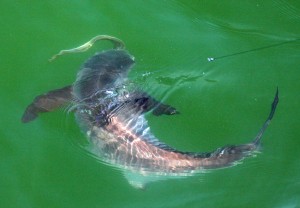 eat.
eat.
Cobia cruising in open water have always been a fish of opportunity. If you happened to see one and had something ready to cast, you could make your whole day. To our south, hunting for cruising cobia has been the technique of choice. Here in the Chesapeake, only a few anglers would hunt the open waters at the mouth of the bay. This was mainly done during the month of August when the fish would start to pod up. Other than that, you sat on a chum slick or looked for cobia on the buoys and pilings. Things have changed.
Stalkers
Now, as soon as the cobia arrive, there is a fleet of specially modified boats, out on the prowl, hunting for surface swimming cobia. They will continue to stalk these fish until they leave the bay in the fall. When conditions are right, 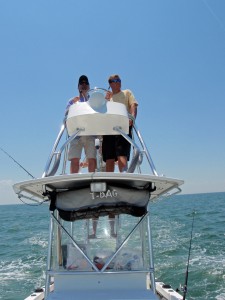 this technique can be very productive. More importantly, it is just plain fun! Many find stalking cobia much more exciting than sitting on a chum slick. It is more like hunting big game than fishing.
this technique can be very productive. More importantly, it is just plain fun! Many find stalking cobia much more exciting than sitting on a chum slick. It is more like hunting big game than fishing.
Old and New School
Capt. Jorj Head is one of the top cobia anglers in the Chesapeake Bay. He has taught many the fine points of successfully catching cobia from an anchored boat. He was also one of the early cobia stalkers in the bay. I joined him many years ago with a video camera in hand. We made a film, of fishing for surface cruising cobia, that was used to show the technique to local fishing clubs. That was old school. I met up with Jorj and his young 1st mate, Ken Braddy, to find out what is happening now. They were fresh off a 2nd place finish in the Hampton Creek Cobia Tournament and were on the fish.
The Boat
Stalking cobia can be done from any boat but it soon became apparent that sighting these fish was easier from a high vantage point. Boats were running around with stepladders secured in various ways. That led to more stable sighting platforms. These early towers did the trick but communication problems were discovered. It was fine that the angler up top could see a fish, but trying to relay that information down to the driver created some interesting exchanges. Today, these cobia-hunting stations have steering controls and electronics so that these cobia hunting machines can be run from up top. There will be several rod holders up top so that a quick cast can be made to a sighted cobia. What these raised casting platforms do not have is shade. A top would get in the way of casting. Use of a good sunscreen is very important.
Seeing Is Believing
When sight-fishing for cobia, being able to see them is everything. Clear sunny days are best. I have always thought that slick calm days were needed but both Jorj and Ken say that sometimes it is actually easier to spot them in the waves. Visibility is best when the sun is high in the sky and you need to keep the sun at your back. Ken thinks that 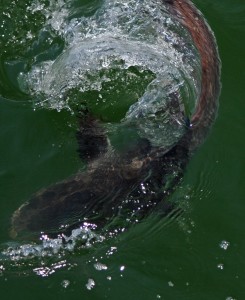 it easier to spot cobia in the face of the waves (looking into the wind). Jorj feels that he can spot them fine both in the face and in the back of the waves but casting is much easier if you are up-wind of the fish. A pair of quality sunglasses is essential. Jorj is a member of the Costa Pro Staff. He does not like blue or gray lenses for this type of fishing. He says that the amber or Vermillion lenses give him much better visibility.
it easier to spot cobia in the face of the waves (looking into the wind). Jorj feels that he can spot them fine both in the face and in the back of the waves but casting is much easier if you are up-wind of the fish. A pair of quality sunglasses is essential. Jorj is a member of the Costa Pro Staff. He does not like blue or gray lenses for this type of fishing. He says that the amber or Vermillion lenses give him much better visibility.
Bait and Tackle
Both spinning and bait casting tackle is used and they use both braided and monofilament line. The braid is in the 50-65 pound test range. The mono is 25-30 pound test. The main baits are jigs and live eels. Jorj likes spinning tackle to cast the live eels. Bait casters give him more control when he is casting jigs. They will use a short leader of 80-pound test mono. Hook sizes are in the 7/0 to 8/0 range depending on the size of the eel used. In general, he uses smaller eels when casting than he does when fishing a chum slick. Both Ken and Jorj prefer a 2-ounce bucktail jig with a curly tail, rubber trailer.
The Jig Is Up
When casting jigs, they want to cast ahead of the fish and beyond the path it is following and work it back past the fish. The jig is worked back to the boat very fast. They will crank as fast as they can and will also use the rod to rip the jig through the water. Jorj says that you are looking for a reaction strike. He does not want the cobia to get a 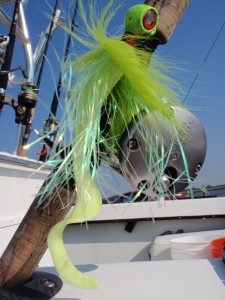 good look at his jig. He wants that fish to have to make a split-second decision. When we had a cobia turn to strike a jig and then turn off of it, Jorj said that fish got too good a look.
good look at his jig. He wants that fish to have to make a split-second decision. When we had a cobia turn to strike a jig and then turn off of it, Jorj said that fish got too good a look.
Eeling
Keeping with the reaction strike theme, Jorj wants very lively eels. There is none of this “keeping them on ice to calm them down” stuff. He keeps his eels in a livewell. The eel on a hook, ready to be cast, is kept in a bucket of water and the water is changed often. During these sunny summer days, that water can heat up fast. If the eel is not lively, he will change it for a fresh one. When a cobia is spotted, cast the eel out in front of the fish and let the lively eel draw a strike from the cobia. Keep your reel in free-spool and give the cobia several seconds to process the eel, then reel tight and set the hook. For casting, Jorj likes to hook his eels through the mouth. He hooks them through the tail when chumming for cobia.
Where
Cobia can pop up almost anywhere. Some areas will be more productive than others. These anglers will look for cobia on the buoys and the Chesapeake Bay Bridge Tunnel pilings later in the summer but what makes this different than “running the buoys” is the amount of time spent hunting open water. Look for cobia along the edges of the main channels coming into the Chesapeake Bay. Often, you will find them along tide lines. Around the same ledges and hills that anglers anchor and chum for cobia can be good areas to spot cobia. Look for schools of bunker. Jorj says that often you will see cobia just following (15-20 feet behind) a school of bunker. We saw this several times the day I fished with them.
Not Every Day is for Stalking
Jorj prefers sight-fishing for cobia. He thinks that it is just more fun. Conditions are not always right for this technique though and to be consistently successful, cobia anglers need to be able to fish other techniques. When the skies are cloudy with a stiff NE breeze, it is time to anchor up and break out the chum. 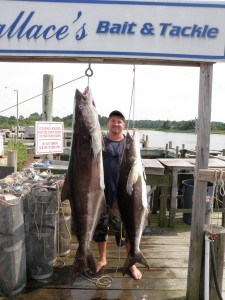
The Captain
Capt. Jorj Head has been fishing the waters of the Chesapeake Bay all of his life. He has appeared in national television shows and magazines for his fishing expertise. In addition to being a fishing guide, Jorj is also a school teacher. Capt. Jorj does not just catch cobia, he also helps to study them. This past year, he tagged and released more cobia than any other angler in the Virginia Game Fish Tagging Program. He is currently collecting tissue samples to be used for DNA analysis at the Virginia Institute of Marine Science. To contact Fish Head Charters call: (757) 262-9004.
The Mate
In his short fishing career, Ken Braddy has accomplished a lot. He is one of the top young cobia anglers in the world. He currently holds two IGFA World Records for cobia. His 78.5-pound cobia is the current Small-Fry World Record. Ken now is in the Junior age group where he also holds the current IGFA World Record. That record fish weighed in at 86 pounds.
